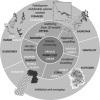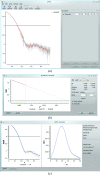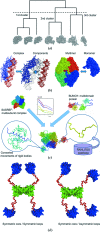New developments in the ATSAS program package for small-angle scattering data analysis
- PMID: 25484842
- PMCID: PMC4233345
- DOI: 10.1107/S0021889812007662
New developments in the ATSAS program package for small-angle scattering data analysis
Abstract
New developments in the program package ATSAS (version 2.4) for the processing and analysis of isotropic small-angle X-ray and neutron scattering data are described. They include (i) multiplatform data manipulation and display tools, (ii) programs for automated data processing and calculation of overall parameters, (iii) improved usage of high- and low-resolution models from other structural methods, (iv) new algorithms to build three-dimensional models from weakly interacting oligomeric systems and complexes, and (v) enhanced tools to analyse data from mixtures and flexible systems. The new ATSAS release includes installers for current major platforms (Windows, Linux and Mac OSX) and provides improved indexed user documentation. The web-related developments, including a user discussion forum and a widened online access to run ATSAS programs, are also presented.
Keywords: ATSAS; biological macromolecules; computer programs; data analysis; isotropic scattering; small-angle scattering; structural modelling.
Figures




Similar articles
-
ATSAS 3.0: expanded functionality and new tools for small-angle scattering data analysis.J Appl Crystallogr. 2021 Feb 1;54(Pt 1):343-355. doi: 10.1107/S1600576720013412. eCollection 2021 Feb 1. J Appl Crystallogr. 2021. PMID: 33833657 Free PMC article.
-
Computational methods for the analysis of solution small-angle X-ray scattering of biomolecules: ATSAS.Methods Enzymol. 2023;678:193-236. doi: 10.1016/bs.mie.2022.09.019. Epub 2022 Oct 31. Methods Enzymol. 2023. PMID: 36641208 Review.
-
SASfit: a tool for small-angle scattering data analysis using a library of analytical expressions.J Appl Crystallogr. 2015 Sep 20;48(Pt 5):1587-1598. doi: 10.1107/S1600576715016544. eCollection 2015 Oct 1. J Appl Crystallogr. 2015. PMID: 26500467 Free PMC article.
-
ATSAS 2.8: a comprehensive data analysis suite for small-angle scattering from macromolecular solutions.J Appl Crystallogr. 2017 Jun 26;50(Pt 4):1212-1225. doi: 10.1107/S1600576717007786. eCollection 2017 Aug 1. J Appl Crystallogr. 2017. PMID: 28808438 Free PMC article.
-
Small-angle X-ray and neutron scattering as a tool for structural systems biology.Biol Chem. 2010 Jul;391(7):737-43. doi: 10.1515/BC.2010.093. Biol Chem. 2010. PMID: 20482320 Review.
Cited by
-
Role of Δ1-pyrroline-5-carboxylate dehydrogenase supports mitochondrial metabolism and host-cell invasion of Trypanosoma cruzi.J Biol Chem. 2015 Mar 20;290(12):7767-90. doi: 10.1074/jbc.M114.574525. Epub 2015 Jan 26. J Biol Chem. 2015. PMID: 25623067 Free PMC article.
-
ATSAS 3.0: expanded functionality and new tools for small-angle scattering data analysis.J Appl Crystallogr. 2021 Feb 1;54(Pt 1):343-355. doi: 10.1107/S1600576720013412. eCollection 2021 Feb 1. J Appl Crystallogr. 2021. PMID: 33833657 Free PMC article.
-
Structural photoactivation of a full-length bacterial phytochrome.Sci Adv. 2016 Aug 12;2(8):e1600920. doi: 10.1126/sciadv.1600920. eCollection 2016 Aug. Sci Adv. 2016. PMID: 27536728 Free PMC article.
-
Integrative analysis reveals structural basis for transcription activation of Nurr1 and Nurr1-RXRα heterodimer.Proc Natl Acad Sci U S A. 2022 Dec 6;119(49):e2206737119. doi: 10.1073/pnas.2206737119. Epub 2022 Nov 29. Proc Natl Acad Sci U S A. 2022. PMID: 36442107 Free PMC article.
-
Structural studies of the yeast DNA damage-inducible protein Ddi1 reveal domain architecture of this eukaryotic protein family.Sci Rep. 2016 Sep 20;6:33671. doi: 10.1038/srep33671. Sci Rep. 2016. PMID: 27646017 Free PMC article.
References
-
- Andersen, C. B., Becker, T., Blau, M., Anand, M., Halic, M., Balar, B., Mielke, T., Boesen, T., Pedersen, J. S., Spahn, C. M., Kinzy, T. G., Andersen, G. R. & Beckmann, R. (2006). Nature (London), 443, 663–668. - PubMed
-
- Bernadó, P. (2010). Eur. Biophys. J. 39, 769–780. - PubMed
-
- Bernadó, P., Mylonas, E., Petoukhov, M. V., Blackledge, M. & Svergun, D. I. (2007). J. Am. Chem. Soc. 129, 5656–5664. - PubMed
-
- Bernstein, F. C., Koetzle, T. F., Williams, G. J., Meyer, E. F., Brice, M. D., Rodgers, J. R., Kennard, O., Shimanouchi, T. & Tasumi, M. (1977). J. Mol. Biol. 112, 535–542. - PubMed
-
- Bertini, I., Giachetti, A., Luchinat, C., Parigi, G., Petoukhov, M. V., Pierattelli, R., Ravera, E. & Svergun, D. I. (2010). J. Am. Chem. Soc. 132, 13553–13558. - PubMed
LinkOut - more resources
Full Text Sources
Other Literature Sources
